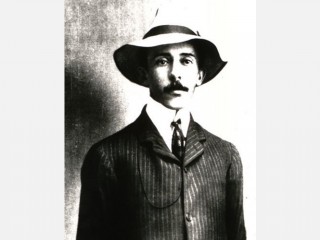
Alberto Santos-Dumont biography
Date of birth : 1873-07-20
Date of death : 1932-07-23
Birthplace : Palmiras, Minas Gerais, Brazil
Nationality : Brazilian
Category : Science and Technology
Last modified : 2010-11-15
Credited as : Pioneer of aviation, inventor of dirigibles and airplanes, autobiography My Airships: The Story of My Life (1904)
Alberto Santos-Dumont was a Brazilian inventor of dirigibles and airplanes. He was the first man to successfully combine the internal combustion engine with ballooning, and Europeans long believed him to be also the first to fly a heavier-than-air motorized plane.
Alberto Santos-Dumont the grandson of a French emigrant to Brazil, was born in the state of Minas Gerais. His father was an engineer, entrepreneur, and coffee planter, married to the daughter of a distinguished Brazilian family. In 1891 Alberto was sent to Paris to study mechanics and other sciences, more or less on his own. His father's death the next year left Alberto a fairly wealthy young man. After 4 years of desultory studies, the alternately dreamy and practical Brazilian began to devote all his money and energy to his inventions.
The idea of flight had long exerted a strange fascination for the boy; and as a wealthy and daring young man, he was also one of the first Parisians to invest in a gasoline-driven automobile. He made his first balloon flight in the spring of 1898, blown by the wind and depending for ascent and descent on the careful balancing of ballast and gas-produced lift. Like many others at the time, he was struck by the possibility of attaching a gasoline motor with propeller to a balloon and thus being able to drive against the wind as well as to change altitude by pointing the craft upward or downward. He was the first to succeed in doing so (fall 1898), 2 years before the successful flight of the rigid dirigibles later known as Zeppelins. In 1901, after several setbacks, he won the Deutsch de la Meurthe Prize of 100,000 francs and much acclaim for the first airship to complete a specified circuit around the Eiffel Tower and back within a half hour.
A few years later Santos-Dumont turned his attention to manned flight in craft that were heavier than air. In September 1906 he flew the "14-bis," an awkward machine resembling a box kite, for a few feet, and within the next 2 months he won prizes for the first aircraft to fly 25 meters and the first to do 100. Three years earlier the Wright brothers had flown in the United States, but their feat had been at first ignored and then systematically denied by most of the American press, so that Europeans hailed Santos-Dumont as the first man to fly. As often happens with inventors, others were fast on his heels, and his own achievement hastened their work. A few months later he himself flew all over Paris in a new and graceful instrument of his design that resembled a modern airplane.
In 1910 Santos-Dumont retired from aviation, apparently because of the onset of multiple sclerosis. He then entered a period of slow physical and mental decline ending in his suicide in Brazil at the age of 59.
Santos-Dumont's autobiography is My Airships: The Story of My Life (1904). Peter Wykeham, Santos-Dumont: A Study in Obsession (1963), is a balanced, fair account that avoids both adulation and deprecation, but it is inadequately documented. An older account is Henrique Dumont Villares, Santos-Dumont: The Father of Aviation (trans. 1956).
Wykeham, Peter, Santos-Dumont, New York: Arno Press, 1980, 1962.
















